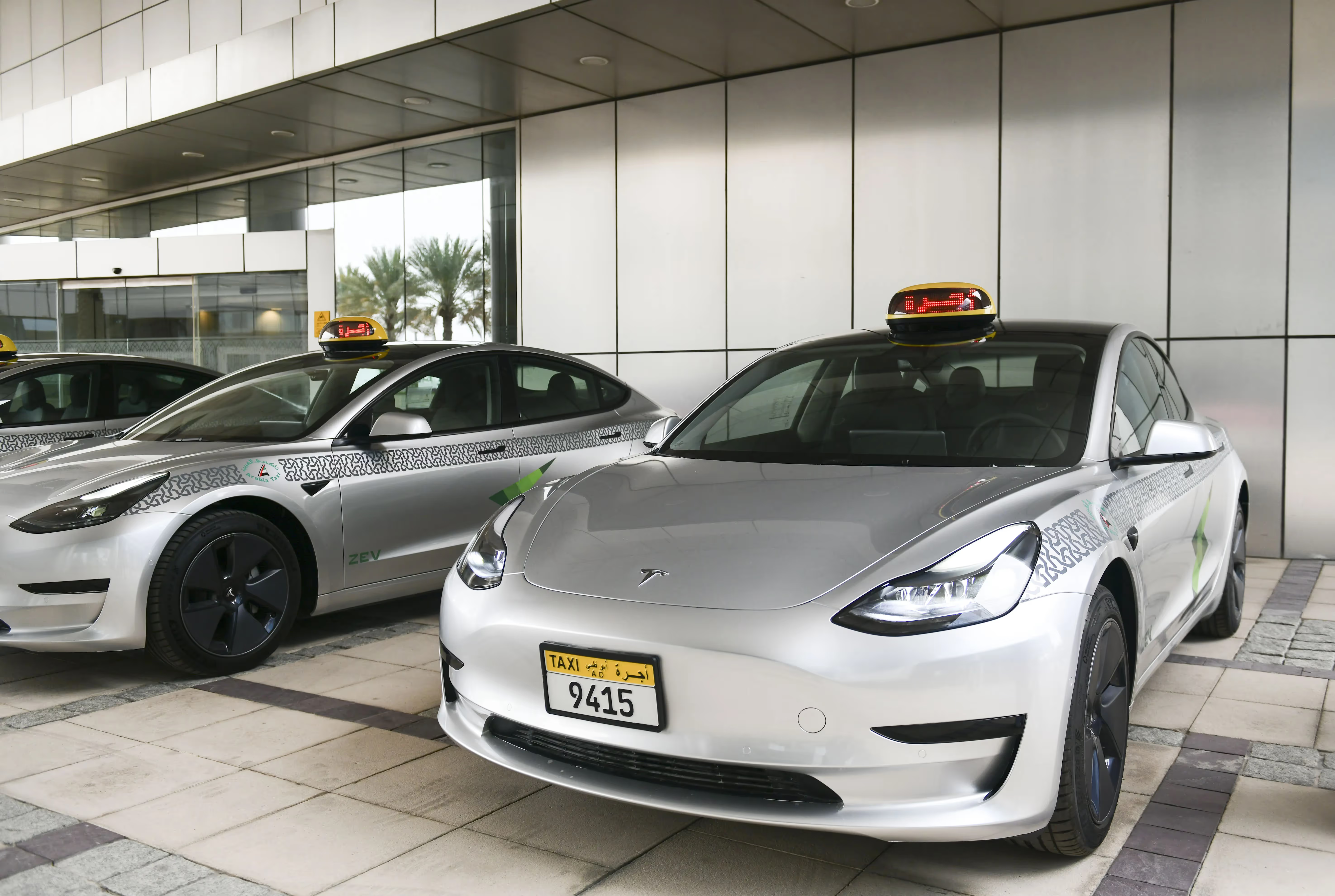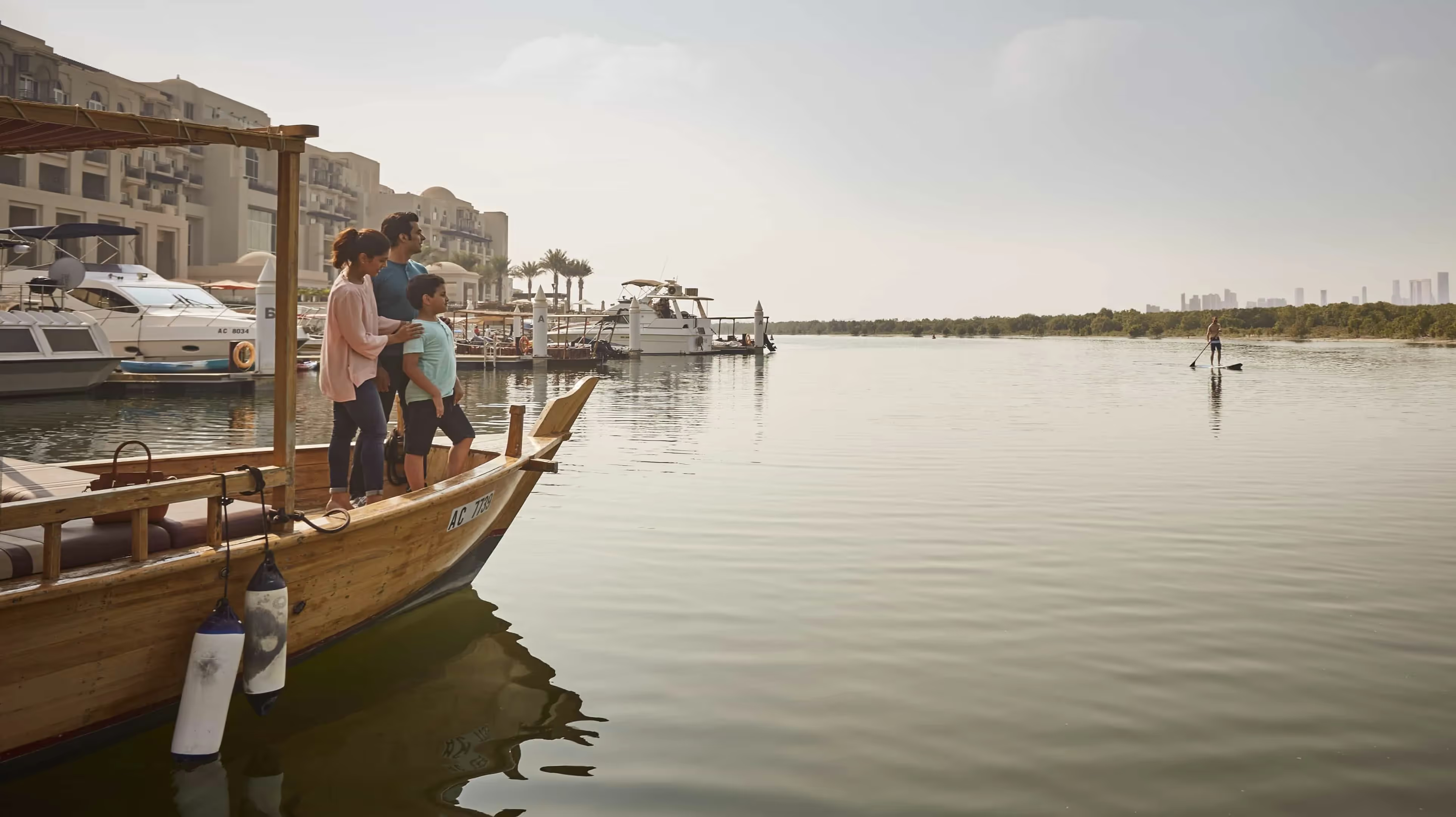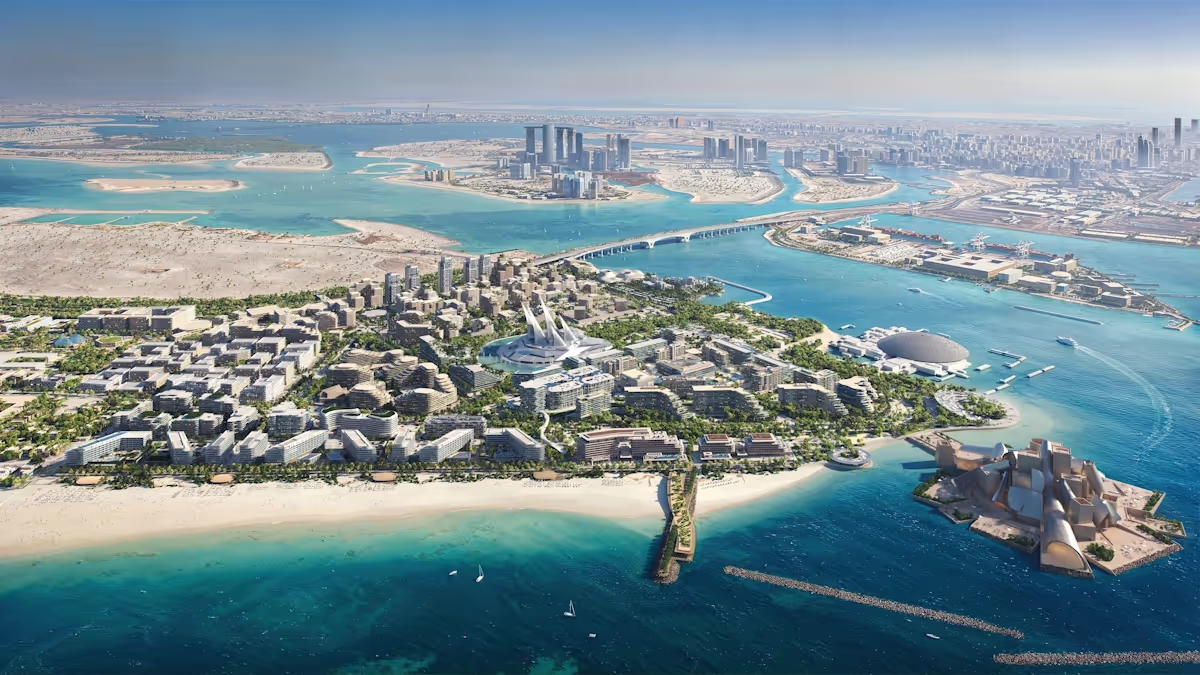Your Guide to Getting Around: Public Transport in Abu Dhabi
Using public transport in Abu Dhabi is relatively simple, especially compared to Dubai. Buses, taxis, ferries and trackless trams are the main ways to get around the city. By 2030, a metro system is also scheduled to open, further adding to the options available.
Public transport in Abu Dhabi is managed by the Department of Urban Planning and Municipalities (DPM) and the Integrated Transport Centre (ITC) which oversees the road sector, including parking, traffic monitoring and freight logistics among other things.

Buses
Bus services were introduced in Abu Dhabi in 2008 and by 2024, the emirate had added 124 routes. These buses operate throughout the city, including the eastern Al Dhafra and western Al Ain areas, with its system divided into regional and urban services.
Bus routes may have numerical or alphabetical prefixes:
- "A" routes only travel to and from Zayed International Airport.
- "M" routes operate on a Hail & Ride system, and were introduced experimentally in 2018.
- "X" denotes express buses for rapid trips.
Note: The Hail & Ride system requires you to signal to the driver in order to get on or off the bus.
Transport follows a schedule, which may be restricted on Fridays and Saturdays. Exact timetables can be checked via the Darbi mobile app.
Each bus is divided into women's and men's sections. Directly behind the driver is the women’s section, reserved for women and children only, while the rest of the bus is available to men.
All buses are air-conditioned and designed to be accessible by passengers with limited mobility. Bus stops are air conditioned, and have smart card top-up machines and displays for delays and schedule changes.
Important! Google Maps now has a feature to track bus routes in Abu Dhabi in real-time. This is handy when you don’t have the app or, for instance, if you have just arrived in the UAE capital.
Over the past five years, the ITC has continually improved bus services in the Emirate. In addition to air-conditioned bus stops throughout Abu Dhabi, free Wi-Fi has also been provided, along with about a dozen free tourist routes which are used by both locals and foreigners.
Hafilat Card: Start using transport in Abu Dhabi
In Abu Dhabi, buses are the main form of public transport, so it's helpful to purchase a Hafilat smart card upon arrival to the city. This card allows you to pay your bus fare electronically, but is only valid on Abu Dhabi's buses and cannot be used elsewhere.
To pay your fare, simply swipe the card at the scanner when getting on the bus. The cost of travel within Abu Dhabi is AED 2 (USD 0.54), with an additional AED 8 (USD 2.20) per mile on regional trips. Unlike taxis, ferries and trams, cash payments are not accepted on Abu Dhabi buses.
General use cards cost AED 10 (USD 2.7) at any Ticket Vending Machine (TVM) and are valid for five years. A personalised card, which includes your details and is valid for 16 years, costs AED 5 (USD 1.36) and are available at bus stations or Customer Happiness Centres.
The maximum top-up amount for the card is AED 150 (USD 41), which can be done via TVM and the Darbi mobile app or at hafilat.darb.ae. For students, senior citizens and people with disabilities using a personalised card, city travel is free, and there is a 50% discount on regional trips. For frequent travellers, there are two types of passes available: a weekly pass for AED 30 (USD 8.2) and a monthly pass for AED 80 (USD 21.8) for unlimited travel.
Important! If you are travelling by bus from Abu Dhabi to Dubai, you can use the Hafilat card to get there, but you must switch to a NoI card in Dubai in order to use the buses there.
Metro
Abu Dhabi plans to create its own twelve station metro network by 2030. As of April 2024, this is still in the planning phase and construction has not yet started. The system will be designed similarly to the Dubai Metro and will cover the entire emirate, connecting mainland Abu Dhabi with Al Raha, Yas Island and Saadiyat Island. Upon completion, the total length of the transport network will be 81.4 mi, including an 11-mi partially underground metro line, two light rail lines and a rapid bus transport system. The metro project is expected to cost around AED 7B (USD 1.91B).

Taxi
Taxis are among the best ways to get around Abu Dhabi. Although there are many different taxi companies, all are regulated by the Centre for Regulation of Transport by Hire Cars (TransAD). These vehicles are easily identifiable by their silver colour and yellow roofs.
There are many various taxi options: airport taxis with ample luggage space, "pink taxis" driven by women exclusively for women and children under 10 years and family taxis offering 4-7 seats. TransAD has launched Mercedes-Benz Vito taxis equipped for people with disabilities. These vehicles feature Wi-Fi and onboard cameras.
Interesting! Over 85% of taxis in the capital run on natural gas or are hybrids, contributing to environmental sustainability.
You can easily get a taxi near hotels, shopping centres or through mobile apps like Abu Dhabi Taxi, Uber, Careem or by calling the TransAD call centre at 600-535-353. Most drivers are well-acquainted with Abu Dhabi, but since exact addresses are often unavailable, it's best to provide a nearby landmark as your destination.
Taxi fares are quite reasonable, especially for short distances. Payment can be in cash or by card through the app.
Standard rates from 6:00 AM to 10:00 PM include:
- A minimum fare for any trip is AED 15 (USD 4.08)
- Pick-up charge is AED 5 (USD 1.36)
- Airport pick-up is AED 20 (USD 5.45)
- Mercedes-Benz Vito to the airport is AED 25 (USD 6.81)
- Per mile (up to 31 mi) is AED 2.90 (USD 0.80)
- Per minute of waiting time is AED 0.5 (USD 0.14)
- Booking fee is AED 4 (USD 1.09)
Night rates from 10:00 PM to 6:00 AM are slightly higher:
- Minimum fare remains AED 15 (USD 4.08)
- Pick-up charge increases to AED 5.5 (USD 1.5)
- Airport pick-up remains AED 20 (USD 5.45)
- Mercedes-Benz Vito to the airport is AED 25 (USD 6.81)
- Per mile (up to 31 mi) is AED 2.93 (USD 0.80)
- Per minute of waiting time remains AED 0.5 (USD 0.14)
- Booking fee increases to AED 5 (USD 1.36)
Important! Taxis in Abu Dhabi offer a 50% discount for disabled passengers and pensioners.
At Abu Dhabi airports, there are dedicated taxi companies. If you take a taxi from here, you will pay at least AED 70-80 (USD 19-22). Economy, business or premium class taxis are available.
Other forms of public transport
In addition to taxis and buses, residents and tourists in Abu Dhabi can use trams and Abra (Abra Water Hopping).
Trams
In early October 2023, a system of trackless hybrid buses/trams was launched. The Autonomous Rapid Transit (ART) tested this service on Yas Island and then expanded it to other parts of the city. Trams run in Abu Dhabi on Fridays, Saturdays, and Sundays, connecting shopping centres like Reem Mall and Marina Mall.
They also pass through popular locations such as Galleria Al Maryah Island, Marina Square, Sheikh Hazza Bin Sultan Mosque, Qasr Al Hosn Museum, Khalidiya Park, Sheikha Fatima Park, Corniche, NMC Specialty and LLH hospitals and hotels like City Seasons Al Hamra, Sheraton Al Khalidiyah and Rixos Marina Abu Dhabi.
The first departure from Reem Mall is at 10:00 AM and from Marina Mall at 11:00 AM. Timetables are available via Google Maps and the Darbi mobile app. Tram stops are marked on pavements with special signage.

Abra (Abra Water Hopping)
Operated by Captain Tony's, Abra is geared towards tourists. This boat-bus ride is one of the most exciting ways to see the UAE capital's landmarks. It operates daily from 4:00 PM to 11:00 PM, except Mondays, and goes between Khor Al Maqta, Eastern Mangroves and Yas Marina hotels, costing AED 25 (USD 6.81) per person. Children under six travel free, while teachers and students can enjoy discounts of 50% and 40% respectively.
There are three Abra Water Hopping routes:
- The Yellow Route: Starts at Souk at Qaryat Al Beri, passes by Shangri-La Hotel and ends at Eastern Mangroves, moving towards the Mangrove Reserve.
- The Red Route: Covers the Khor Al Maqta area, passing by Souk at Qaryat Al Beri, Shangri-La Hotel, The Ritz-Carlton Abu Dhabi and Fairmont Bab Al Bahr.
- The Blue Route: Connects hotels in the Khor Al Maqta area such as Souk at Qaryat Al Beri, Shangri-La Hotel and world-famous Yas Island.
Abra Water Hopping services are only available by reservation, so book your seats in advance by calling +971501332060.
Access for disabled on public transport
Authorities in Abu Dhabi ensure that public transport is accessible for disabled individuals by continually improving walkways, underpasses, public parking areas, building entrances and buses.
Abu Dhabi also offers advantages such as:
- 50% discount on transport
- Parking spaces in public lots
- Free parking
Abu Dhabi's public transport apps
To simplify using public transport in Abu Dhabi, it's best to install apps that provide route information, arrival times, schedule changes, taxi booking and Hafilat smart card top-up. These apps are available on the App Store and Google Play.
Popular mobile apps include:
- Darbi: Essential for every Abu Dhabi resident and tourist, offering details on transport routes, fares, parking, traffic, holiday bus schedules and more. It features an essential interactive map and is available in Arabic and English.
- Uber, Careem, Abu Dhabi Taxi: These apps allow you to book taxis with GPS assistance, cancel bookings, view detailed fare information, along with driver and vehicle details and the history of previous bookings.
- Rubban: Providing accurate and efficient interactive maps with details on yacht marinas and marine transport routes.
- Abu Dhabi Link: Book a shared bus at your desired time without a traditional bus schedule. This service operates in Al Shahama, Al Bahiya, Al Rahba, Al Samha, parts of Al Sader area and on Yas Island and Saadiyat Island, with fares equivalent to traditional buses. Payment can be made using the smart card.
Tips for using public transport
Stick to certain rules when using public transport in Abu Dhabi:
- Eating or drinking on public transport is prohibited. This may upset fellow passengers, and taxi drivers may refuse you service.
- Buses have designated sections for women, children and families. It is forbidden for men to travel in the women's section.
- Ask for a receipt after your taxi ride. In case you leave any belongings in the taxi, you can contact the call centre and they will connect you with the driver.
- Ensure your smart card is topped up.
- Illegal parking can result in a fine of AED 1,000 (USD 272).
In line with the Abu Dhabi 2030 development plan, the government is working to establish an innovative and environmentally friendly transport system that meets the highest global standards and focuses on renewable energy sources which reduce carbon emissions. Personal Rapid Transit technology, also known as self-operated transport, has already been integrated, along with the introduction of driverless electric buses in late 2023.
According to the Swiss International Institute for Management Development (IMD) Smart City Index 2024, Abu Dhabi was ranked among the top ten smartest cities in the world based on several categories, one of which is public transport, which has seen 80% improvement in recent years.
Reaching a daily flow of nearly a quarter of a million passengers, Abu Dhabi's public transport is loved by all thanks to its convenience, constant improvements and overall quality.






